
 Five generations of one family and a very long history from 1882 of 135 years of continuous shipowning and ship management have made The Schulte Group into one of the greatest ship management businesses with worldwide general cargo, container, gas tanker and specialised fleets. In 1950, the fleet had to be rebuilt from almost nothing after the devastation of World War II into a vast fleet today of over six hundred owned and managed vessels. This is due to the willingness of the Schulte family to engage in joint ventures and enterprises with like minded banking and leasing companies to build up the business. It is true that the shipping freight rates since 1950 have nearly always been good, but even in the very bad trading markets of the late 1970s and early 1980s, the Schulte family kept going with skill and determination to ride the financial storms until the good markets prevailed again.
Five generations of one family and a very long history from 1882 of 135 years of continuous shipowning and ship management have made The Schulte Group into one of the greatest ship management businesses with worldwide general cargo, container, gas tanker and specialised fleets. In 1950, the fleet had to be rebuilt from almost nothing after the devastation of World War II into a vast fleet today of over six hundred owned and managed vessels. This is due to the willingness of the Schulte family to engage in joint ventures and enterprises with like minded banking and leasing companies to build up the business. It is true that the shipping freight rates since 1950 have nearly always been good, but even in the very bad trading markets of the late 1970s and early 1980s, the Schulte family kept going with skill and determination to ride the financial storms until the good markets prevailed again.
Schulte And Bruns
The first generation of the Schulte family of shipowners set up in business in 1882 as ship’s agents and shipbrokers as Schulte and Bruns in Papenburg. Konsul Johann Hermann Schulte (1847-1920) from Leer and his partner Christoph Bruns from Brake worked together on the quayside at Papenburg. This quay was located not too far from the giant modern day cruise ship building shipyard of Meyer Werft. The schooner Immanuel, owned by J. J. Wallis and Son, called at Papenburg with cargo on 20th February 1882, and this is taken as the starting date of the business. On 18th January 1883, the business was officially registered in Papenburg, the town having a big fleet of 190 seagoing ships and 23 shipyards at this time. Schulte and Bruns established a branch in Emden in 1892, with the Schulte partner moving to Emden, and the Bruns partner remaining in Papenburg, both continuing in business as Schulte and Bruns.
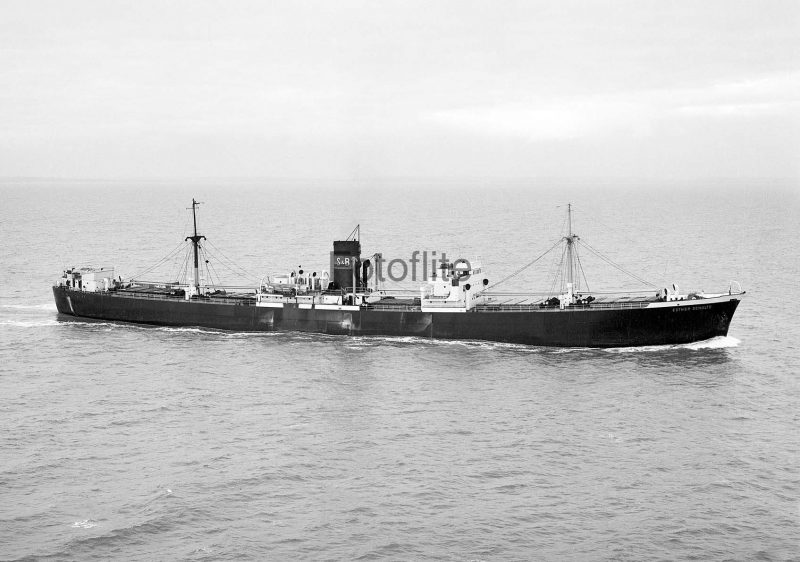
Twelve sailing ships were owned over the period from 1888 to World War I and were traded in the Baltic Sea and North Sea timber trades. These including black hulled three masted wooden schooners and brigantines registered at Papenburg such as Adolphine of 230 grt built in 1872 at Quebec, Albion of 366 grt built in 1863 at Elbing, Alpha of 118 grt built at Papenburg in 1855, Balthasar of 287 grt built in 1877 at Ribnitz and in the fleet from 1896 to 1902, Elisabeth (ex Christine) of 143 grt built in 1857 at Papenburg, Germania of 516 grt built in 1866 at Danzig, Immanuel of 229 grt built in 1861 at Griefswald, M. B. Cohn of 241 grt built in 1866 at Rostock, and Victoria of 257 grt built in 1867 at Arichat in Nova Scotia.
The first steamship was purchased in 1912 as Cora of 3,700 dwt and was renamed Konsul Schulte after her owner. She had been built in France in October 1906 as Deux-Sevres as one of six identical steamers for Compagnie de Navigation d’Orbigny-Faustin (A. Capelle et Compagnie of La Rochelle) by the Forges et Chantiers de la Mediterranean at Graville near Le Havre. Her ‘three island’ sisters were Vendee, Indre, Sarthe, Mayenne and Loiret, and had overall lengths of 89.9 metres, beam of 13.4 metres and draft of 6.5 metres, and had a service speed of ten knots from a triple expansion steam engine. Konsul Schulte was traded for five years during World War I until sold in 1917 for the high prices then obtainable. She was renamed Tebea and after three more changes of name was wrecked to the east of Okujiri Island on 20th April 1930.
In 1917, the inevitable separation of the Schulte and Bruns partners was agreed upon by both partners, with Konsul Johann Hermann Schulte continuing in business at Emden, and Christoph Bruns continuing in business in Papenburg, both under the name of Schulte and Bruns. The next steamship was also named Konsul Schulte (2) of 4,500 dwt in 1924 when purchased as Cardiff, and had been built in 1898 by the William Gray yard at West Hartlepool for Morel of Cardiff. She had kept her name of Cardiff when sold to the Sovereign Shipping Co. Ltd. (F. Mundy of Cardiff). On 4th November 1931, Konsul Schulte (2) was in collision with the Danish auxiliary schooner Havet in the Baltic Sea off Swinemunde, the schooner capsized and sank.
The inter-war years were the period of management of the second generation of the Schulte family as shipowners, with Konsul Heinrich Schulte (1876-1937) and Johann Schulte (1877-1938). Medium sized steam tramps were purchased for worldwide trading, and were first registered under Schulte and Bruns before being transferred to the ‘Atlas’ Reederei Akties, set up in Emden in 1922.
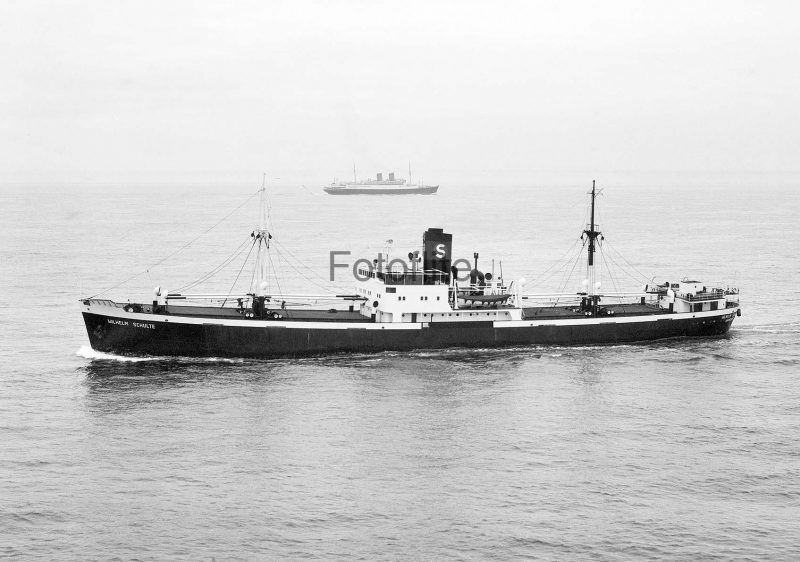
Eleven steam tramps of up to 11,140 dwt were purchased during the inter-war years, they were:-
- Europa of 4,466 grt built as Montenegro in 1898 by the Henderson yard at Glasgow for the African Steamship Co. Ltd. (Elder Dempster, managers) and purchased in 1922.
- Amerika of 3,792 grt, a Doxford ‘Turret’ ship built in 1907 as Redbridge for the Temperley Steam Shipping Co. Ltd. of London (J. Temperley & Company, managers) and purchased in 1923.
- Afrika of 5,545 grt, an engines aft Doxford ‘Turret’ ship built in 1907 as Admiraal de Ruijter for W. H. Muller & Company of Holland, and purchased in 1927.
- Asien of 3,894 grt built in 1905 by the Joseph L. Thompson yard at Sunderland as Hermes for A/S Hermes (Bruusgaard, Kiosterud, managers) and purchased in 1929 from Aaby’s Rederi of Norway.
- Elise Schulte of 5,238 grt built in 1911 by the Riuniti yard at La Spezia as Armando for Societa Commerciale Italiana of Italy, taken over in 1921 in the NGI fleet of Italy, and purchased in 1927 by Schulte and Bruns. She was wrecked on 8th October 1934 on Juister Reef off Bremen while on a voyage from Lulea to Emden with iron ore. She broke in two and became a total loss, her crew were fortunately rescued.
- Elise Schulte (2) of 4,613 grt built in 1913 by the Northumberland Shipbuilding Co. Ltd yard on the Tyne as Rounton Grange for Houlder Brothers, and purchased by Schulte and Bruns at the end of 1934.
- Europa of 3,767 grt built in 1899 by the William Gray yard at West Hartlepool as Claudius for Andersen Brothers of Germany, and purchased in 1929 as Trude from Reederei Stange and Dreyer Gmbh of Stettin. She was sunk in collision on 15th March 1944 near Stavanger.
- Godfried Bueren of 4,664 grt built by the Doxford yard in 1911, but not a ‘Turret’ ship, as Atna for Wilhelm Wilhelmsen of Norway for his trades to Mexico, Africa and Australia, and purchased by Schulte and Bruns in 1925.
- Johann Wessels of 4,601 grt and completed in 1913 by the Irvine yard at West Hartlepool for the Empire Transport Co. Ltd. (Houlder Brothers, managers) and purchased by Schulte and Bruns in 1929.
- Amerika (2) of 7,463 grt and built in 1911 by Swan, Hunter and Wigham Richardson Ltd. in 1911 as Goldenfels for Hansa Line of Bremen, and purchased by Schulte and Bruns in 1936.
- Johann Schulte of 5,344 grt and built in 1921 as Canadian Scottish by the Wallace Shipbuilding and Dry Dock Company at Vancouver, and purchased in 1939 from Greek owners as Mount Parnassos.
- Heinrich Schulte of 5,056 grt and built in 1918 by the Govan yard of Harland & Wolff Ltd. as the standard ship War Legate and purchased in 1937 from Greek owners as Mount Ossa.

Six tramps of the ‘Atlas’ Reederei Akties Ges were trading at the end of the Great Depression in 1935, with the third generation of the Schulte family of shipowners taking over in 1937 in Konsul Bernhard Schulte (1907-1975) and Hans-Heinrich Schulte born in 1909. Their fleet on the outbreak of war in 1939 comprised sixteen tramps engaged in worldwide tramping from offices in Emden, Rotterdam, Hamburg and Duisburg, with an additional fleet of one hundred inland barges on the Rhine to carry coal and iron ore to the Ruhr steel industries. This big tramp fleet was engaged during the war in supplying coal and iron ore from Sweden and Narvik for the German war effort. Ten ships were lost during the war:-
- Johann Schulte wrecked on New Year’s Day 1940 to the south of Kya Light House near Rorvik in Norway.
- Afrika sunk by artillery on 10.4.1940 off Ulvik in Norway.
- Godfried Bueren mined and sunk on 18.1.1941 twenty miles east of Limfjorden, Denmark.
- Johan Wessels attacked and sunk by British aircraft to north west of Juist on 17.9.1941.
- Elise Schulte stranded off Tromso on 10.1.1942, sank next day.
- Konsul Schulte (2) torpedoed and sunk by the Russian submarine SC-421 on 5th February 1942 in Porsanger Fjord while on a voyage to Kirkenes with a general cargo of barracks huts.
- Amerika mined and sunk to east of Terschelling on 21.2.1941, sank next day.
- Heinrich Schulte torpedoed and sunk on 28.1.1944 by Russian submarine S-56 in the White Sea.
- Europa sunk by collision on 15.3.1944 near Stavanger.
- Asien sunk by the British submarine Unshaken on 7.4.144 on a Northern Patrol.
Three ships only were left afloat at the end of the World War II, and this trio was taken over as war reparations by the victorious Allies, and Schulte and Bruns, as with all German shipping companies, were then prevented from making a start in building up their fleet again until 1950.
Schulte And Bruns Shipyard

The shipyard of Schulte and Bruns at Emden, founded in 1917 as a repair yard but also building small coasters, trawlers and tugs e.g. the trawler Vesta of 247 grt was completed in 1922, lengthened and converted to a general cargo vessel in 1957 and is still afloat today as Estelle. The yard then began to build motor vessels and coasters for the Baltic and North Sea trades for the new Schulte and Bruns fleet of post World War II. The yard had four berths and could build ships up to 3,500 dwt. Auguste Schulte of 1,259 dwt was completed in 1951, Lucie Schulte of 2,539 dwt was completed in 1953, Elisabeth Schulte of 3,420 dwt in 1956, Maria Anna Schulte of 3,034 dwt in 1957, and her sister Elise Schulte of 3,034 dwt in 1958. They were powered by diesel or diesel electric engines by Klockner Humboldt Deutz of around 1,200 bhp to 1,600 bhp to give a service speed of twelve knots.
The shipyard built a total of more than 250 ships from 1917 until the last ship, the tug Atlas of 149 grt, was completed in 1986. A trio of 3,100 dwt sister general cargo vessels of Annemarie Schulte, Maria Schulte, and Natalie Schulte was completed by the yard in 1971/72. Annemarie Schulte and her sisters operated in the coal, timber and cellulose trades of the North Sea and the Baltic Sea. Annemarie Schulte sank in a few minutes after a collision on 5th December 1974 with the Cypriot cargoship Ismani of 7,141 grt built in 1944 in Blexen Roads, opposite to the port of Bremerhaven, while on a voyage from Antwerp to Mariestad with the loss of one crew member. The wreck was run into ten days later by the German motor vessel Edelgard and received very major damage to her bridge and hull, with her lifeboats and hold found to be stove in when surveyed after refloating in February 1975. She was abandoned to insurers as a total loss, but was repurchased and repaired by the Schulte and Bruns yard at Emden. She was sold in 1977 to Thien and Heyenga of Hamburg and later lengthened by the Jos. L. Meyer yard at Papenburg in July 1978, and was renamed Gotland II and later broken up. The sister Natalie Schulte is still afloat today, trading as El Castro and registered in the United Arab Emirates, while the third sister Maria Schulte was broken up at Bilbao in April 2009. The trio were powered by six cylinder Klockner Humboldt Deutz diesels of 1,800 bhp to give a service speed of twelve knots.

The family shipyard also built ro-ros such as Ramsgate of 818 grt for Schulte and Bruns, and she was completed in 1973 to import cars from Europe into Ramsgate. She was sold in 1984 and later converted into a livestock carrier, and is still afloat today as Mohamed N registered at Moroni in the Comoros archipelago in the Indian Ocean.
Two more ro-ros completed in 1973 and 1977 as Ville de Corte and Mejerda respectively, were later converted into passenger ro-ros, the former ship becoming Zakinthos I in Greece and the latter ship becoming Tramola 2 for Turkish owners.
There are still three dozen ships built by the Emden yard of Schulte and Bruns afloat and trading today.
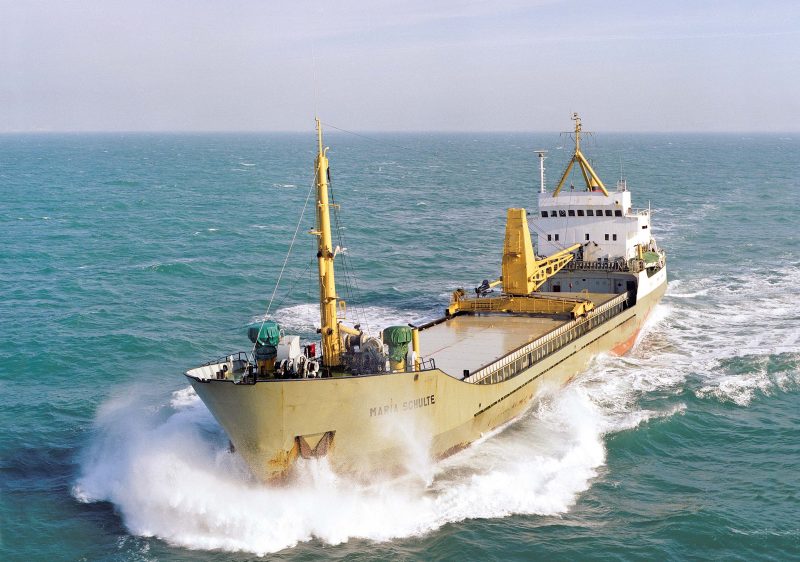
Schulte And Bruns Post-War Fleet
Schulte and Bruns adopted brighter funnel colours in post-war years of two broad green and red bands with ‘S & B’ emblazoned in white on a black funnel, the houseflag being the same with a green upper half and a red lower half bearing ‘S & B’. The deep sea tramping fleet was built up with new and second hand vessels, including the former twin screw motorship Somerville built in 1929 for Klaveness of Norway, and purchased in 1953 as Sachsenwald and renamed Ursula Schulte. She was powered by twin six cylinder B. & W. diesels and had been completed by the Burmeister & Wain yard at Copenhagen. The Fearnley and Eger motorship Ferncliff built in 1924 by the Deutsche Werft yard at Hamburg was purchased in 1957 as Carl Julius and renamed Gunther Schulte and was traded until 1962 when she was broken up at La Spezia. The new motor tramp Ilse Schulte of 10,000 dwt was completed in 1951 by the Nordseewerke yard at Emden on dimensions of length 446.0 feet, beam of 58.0 feet, and draft of 25.0 feet, with a service speed of thirteen knots from a six cylinder M.A.N. diesel of 3,200 bhp.

The former Ropner tramp Seapool was purchased in 1953 as Grunewald and renamed Esther Schulte and had been completed in 1940 by the Burntisland yard. The Furness yard at Haverton Hill on the Tees had completed the tramp Rigi in 1921, and she was purchased in 1957 as Alfred Theodor and renamed Joachim Schulte. The Clydeside yard of William Beardmore had completed the tramp Dalhanna in 1930 for Newcastle owners and was purchased in 1950 as Lord O’Neill from Belfast owners and renamed Johann Schulte. The name of Konsul Schulte (3) was revived in 1950 for an elderly tramp built by the Bartram yard at Sunderland as Flimston in 1925, and she was purchased under the name of Woodham Rover. A converted tanker was traded from 1955 as the tramp Carola Schulte, and had been built as Nord Atlantic in 1938 by the Deutsche Werft yard at Hamburg.
Two new deep sea tramps were completed in 1957/58 by the Lubecker Flenderwerke yard as the six hold engines ‘midships Henriette Wilhelmine Schulte and Ilse Schulte, traded either as open shelterdeckers of 7,197 grt and 10,100 dwt or closed shelterdeckers of 10,060 grt and 15,000 dwt. The pair were used in the iron ore trades from Norway with cargo derricks on four masts and sets of posts, and had a sister Johannes Russ of Ernst Russ and Company, also used in the iron ore trades.
The Lubecker Flenderwerke yard completed in 1960 the six hold engines aft Konsul Schulte (4) of 12,006 grt and 17,228 dwt on dimensions of length 533.0 feet, moulded beam of 66.6 feet, and draft of 32.0 feet with a service speed of sixteen knots from a nine cylinder M.A.N. diesel of 8,150 bhp. She was much used in the grain trades from Vancouver and had many cargo derricks on four masts. The deep sea fleet had been built up to fifteen ships in 1955 and to thirty ships in 1960, with an entry made into the bulk carrier trades in the early 1960s, and managed from 1963 by the fourth generation of the Schulte family, Dr. Heinrich Udo Schulte, born in 1935, and Thomas Schulte, born in 1939, who joined the company in 1967 to build up the in-house chartering department.
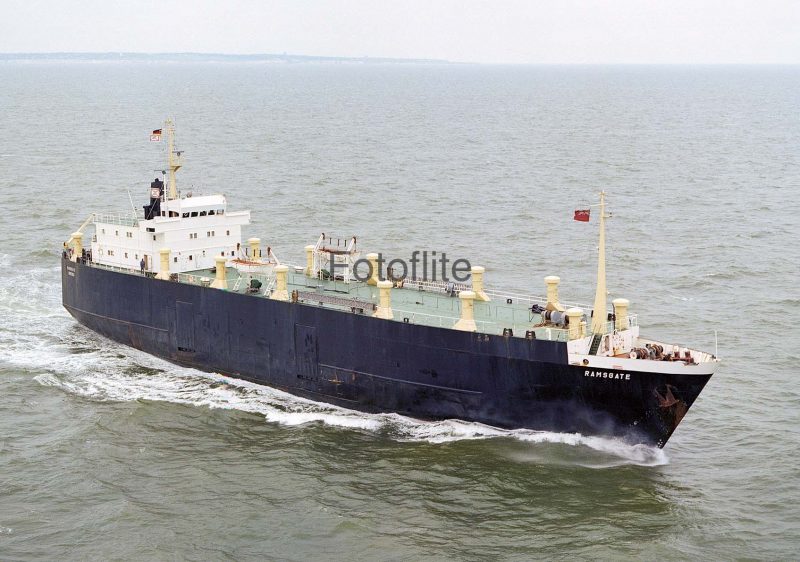
The new bulk carriers helped to swell the worldwide fleet operating on contracts of affreightment, and by 1967 thirteen new ships had been completed in the decade from 1957. The Lubecker Flenderwerke yard, the Deutsche Werft yard at Hamburg, the A.G. Weser yard at Bremen and the Kieler Howaldtswerke yard at Kiel completed ten bulkers up to 1973 in Johann Schulte of 22,700 dwt, Heinrich Schulte of 54,045 dwt, Hermann Schulte of 33,300 dwt, Mathilde Schulte of 76,060 dwt, her sister Susanne Schulte of 76,060 dwt, Johann Schulte of 77,000 dwt, Ursula Schulte of 80,185 dwt, Stadt Wolfsburg of 25,600 dwt, Stadt Emden of 34,500 dwt, and Stadt Bremen of 139,850 dwt.
Smaller general cargo ships including three German ‘Liberty’ ships of 16,300 dwt as Elisabeth Schulte, Elise Schulte and Ilse Schulte in 1972/73, and a trio of 8,100 dwt were completed in 1970/71 as Auguste Schulte, Erike Schulte, and Gunther Schulte. The first small gas tanker had been taken under management in 1968, with later six liquid petroleum gas (lpg) tankers with names beginning with ‘Emstank’ followed by a numeral in the fleet, as well as Anna Schulte, Dorothea Schulte, Hermann Schulte, Immanuel Kant, Kurt Illies, Lissy Schulte and Sophie Schulte carrying up to 7,150 tonnes of propane, butane and ethylene. The big Schulte and Bruns fleet in 1978 had some of the fleet flagged out to Liberia.
Hans-Heinrich Schulte was declared bankrupt in 1977 due to falling freight rates, big increases in oil fuel prices, and the flagging out of ships of competitors to Liberia and Panama. A fleet of thirty owned and one hundred managed ships was operated in 1980, when Ascan Lutteroth, brother in law of both Dr. Heinrich Schulte and Thomas Schulte, joined the Schulte family management team. However, a deep crisis in freight rates struck the shipping industry in 1981 and continued at low levels for several years. At the end of this crisis in 1987, Schulte and Bruns were managing only 22 vessels with little left in cash reserves. Multi-purpose trades to the Mediterranean, Caribbean and North Africa were being operated by Angelina Schulte, Antje Schulte, Christiane Schulte, Judith Schulte, Marianne Schulte and Renate Schulte.

Bernhard Schulte Reederei
The Head Office of the Schulte and Bruns business was moved from Emden to Hamburg in early 1954. Bernhard Schulte resigned from the company on 1st October 1955 to set up his own ship management business, taking four ships from Atlas Reederei with him. These were the new shelterdecker Henriette Schulte of 9,842 dwt as a closed shelterdecker built by Nordeseewerke at Emden, the steamer Christiane Schulte of 2,275 grt and built at Stettin in 1938 as Stettiner Grief, and two new motor coasters of 1,200 dwt, Lissy Schulte and Maria Schulte. The three smaller ships were chartered in the timber trades from the White Sea and the Barents Sea during the summer months, and repositioned during the winter months to the citrus trades from Spain and Morocco. Henriette Schulte was chartered worldwide on the ‘spot’ market.

Bernhard Schulte then began building up an owned and managed fleet from late 1955, with a fleet of fourteen mostly motor general cargo ships of up to 4,500 dwt built up by 1962. These were Angelica Schulte, Christiane Schulte, Elisabeth Henriette Schulte, Esther Charlotte Schulte, Heinrich Udo Schulte, Lissy Schulte, Maria Schulte, Thomas Schulte, the steamers Wilhelm Schulte and Ursula Bock, a Hansa ‘A’ type completed by J. Boel and Sons in 1945. The managed Jan Ten Doornkaat, Gertrud Ten Doornkaat, Flepko Ten Doornkaat and Ellen Klautschke completed the Bernhard Schulte fleet. Christiane Schulte and Thomas Schulte were sisters of 3,575 dwt as closed shelterdeckers as two of eleven identical motorships from the Lindenau yard at Kiel. They had dimensions of length 257.6 feet, moulded beam of 41.0 feet, and draft of 20.0 feet, with three masts and eight derricks of five tonnes capacity, and a service speed of twelve knots from an eight cylinder M.A.N. diesel of 1,680 bhp at 275 rpm.

Bernhard Schulte died in 1975, at which time he was managing a new fleet of twenty general cargo ships of up to 5,000 dwt, including Alexander Schulte, Astrid Schulte, Angelica Schulte, Anna Schulte, Antje Schulte, Christiane Schulte, Judith Schulte, Moritz Schulte, Sophie Schulte, and the managed Jan Ten Doornkaat, Flepko Ten Doornkaat, Friederike Ten Doornkaat, Gertrud Ten Doornkaat, Hamburger Burg, Hamburger Tor, and Kap Roland. The SD14 Cosmopolit was purchased in 1976 from the German owned Infrutra Group and renamed Heinrich Arnold Schulte and was then traded until sold in 1988.
A quintet of engines aft general cargo ships of 11,235 dwt were built in 1982/83 by the Dong Hae Shipbuilding yard at Ulsan for German owners. They were capable of carrying 604 TEU of containers handled by five Vele ‘swinging’ derricks of thirty tonnes capacity on two masts and a goalpost mast on top of the navigating bridge. Elisabeth Schulte, Esther Schulte and Marianne Schulte were completed for Schulte, with Andromache and Andromeda Star for Aug. Bolten of Hamburg. Marianne Schulte and Elisabeth Schulte were sold to the Vietnam National Shipping Lines (VINALINES) in 1997 and renamed Me Linh and Van Xuan, while the other trio of this quintet were chartered to Express Lines in the same year. By 1985, a big fleet was being managed by Schulte for other owners including the general cargo ships Cap Gata and Cap Maleas, as well as a big fleet of owned vessels including many combined general cargo and container vessels.

Hanseatic Shipping Ltd., Cyprus
Due to high taxes in Germany, the first overseas subsidiary was formed in 1972 in Limassol as Hanseatic Ship Management Ltd. with an initial fleet of fourteen ships of up to 6,000 dwt. The owned fleet were six general cargo ships in Caroline Schulte, Clamor Schulte, Donata Schulte, Esther Charlotte Schulte, Franciska Schulte and Johann Christian Schulte, with six managed ships with ‘Blue’ prefixes to their names in Blue Sea, Blue Sky, Blue Sand, Blue Spirit, Blue Saga and Blue Stone. There were four initial shareholders in Bernhard Schulte, A. F. Harmstorff, Jonny Wesch Reederei and Hamburger Seereederei-Kontor, each with a 25% shareholding. The withdrawal of three of these shareholders by 1988 left Bernhard Schulte Reederei as the sole shareholder of the renamed Hanseatic Shipping Co. Ltd. The Limassol office is on the seafront in Limassol in a tower building near the Ayia Napa Cathedral and beside other German ship management firms e.g. Columbia Ship Management and Schoeller Holdings Ltd. The Limassol subsidiary of The Schulte Group later became the biggest of nine overseas subsidiaries set up by the Schulte family.
By 1990, Bernard Schulte Reederei had a fleet of thirty owned vessels and ninety managed vessels, managed from offices in Hamburg, Cyprus, Hong Kong, Bermuda and the Isle of Man. A fleet of ten liquid petroleum gas tankers was being managed by Bernhard Schulte in Christoph Schulte (3,500 dwt), Dorothea Schulte (6,113 dwt), Hermann Schulte (6,140 dwt), Wilhelm Schulte (9,000 dwt), Immanuel Kant (16,228 dwt), Kurt Illies (7,113 dwt), Atrice (8,711 dwt), Ben Flor (9,130 dwt), Gaz Pacific (6,000 dwt), Gaz Victory (11,772 dwt) with two of these on charter to Lauritzen Kosan Tankers. This gas tanker fleet was trading worldwide, in Europe, South Africa, South America, Mediterranean, Red Sea, Persian Gulf, Far East, Australian and Pacific gas trades. Dorothea Schulte was renamed Blue Dream in 2010.
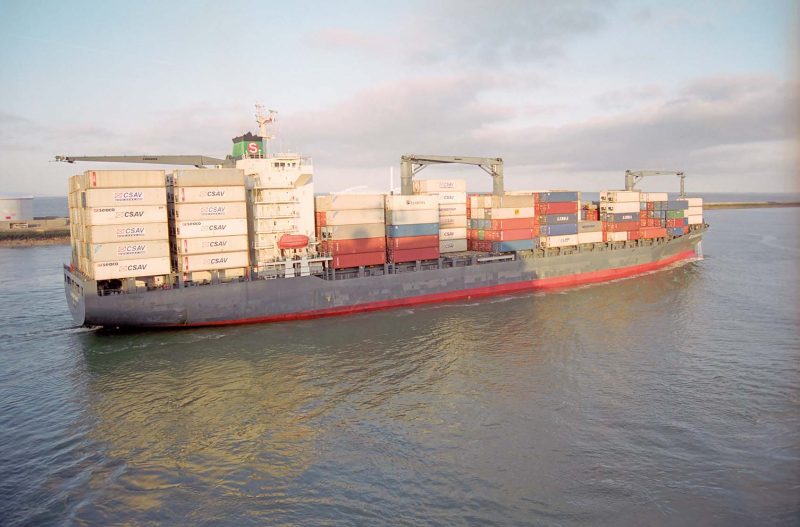
A quintet of new container ships of 1,208 TEU was completed at the Warnowwerft yard in Rostock in East Germany during 1991/92, and marked the beginning of an important fleet of Schulte container ships. The quintet was Auguste Schulte, Donata Schulte, Elise Schulte and two for Peter Dohle A.G. of Germany as Auriga and Carolina. Larger container ships were then delivered to Schulte including the sisters Antje Schulte and Fabian Schulte of 1,608 TEU capacity from a Wismar yard in 1997, the sisters Donata Schulte, Christiane Schulte and Elisabeth Schulte of 2,550 TEU capacity from Hyundai in 2001, the sisters Laura Schulte, Lambert Schulte and Leopold Schulte of 1,750 TEU capacity in 2004 from the Guangzhou Wenchow yard, and Sofia Schulte of 2,825 TEU and Jacob Schulte of 2,550 TEU from yards in China and Korea in 2007, Bernard Schulte of 4,616 TEU capacity in 2010 from the Daewoo yard on Keoje Island, South Korea, and the sisters Lilly Schulte, Lisa Schulte and Martha Schulte of 3,635 TEU capacity delivered in 2010 from a yard in Shanghai. All of these container ships had service speeds of around 22 knots for charter work to large international container ship operators.
OPDR, the German short sea box operator Oldenburg Portugiesische D/S Rederei of Hamburg established in 1882, was acquired by Bernhard Schulte Reederei in 1996. The main services were a weekly service by the ro-ros OPDR Andalucia and OPDR Canarias of 7,300 dwt to the Canary Islands. They had overall lengths of 145 metres, lane lengths of 1,509 metres, cabins for a dozen drivers, capacity for 625 TEU of containers, and service speeds of 16.5 knots from a twelve cylinder four stroke Caterpillar diesel of 8,158 bhp. The pair had their bridges forward with a wide stern door/ramp of 100 tonnes capacity, and containers and trailers were loaded on the Main deck and Upper Deck. OPDR also operated feeder container ships of 700 TEU capacity on other routes, but the Canary Islands route was also operated by the vessels OPDR Cadiz, OPDR Las Palmas, OPDR Lisboa, OPDR Tanger and OPDR Tenerife. This box subsidiary was sold in 2015 to CMA CGM of France after The Schulte Group decided that liner operations with owned vessels were not a core business.
At the Millennium, Bernard Schulte Reederei and the associated companies of Atlantic Marine Ltd., Dorchester Marine Ltd., Eurasia Shipping & Managing Co. Ltd., Hanseatic Shipping Co. Ltd., and Navigo Management Co. Ltd had a big fleet of owned and managed vessels totalling 370 ships employing six thousand seafarers. The owned ships were chartered out to container companies, oil and gas majors, and consortia and other pools e.g. formed with SCAC Delmas of France and Belships of Norway. Thirty of these vessels were container ships on charter to or managed for Maersk Line, MOL, United Arab Shipping Company (UASC), CMBT, CSAV and Hapag-Lloyd, with another six on order in Korea for a five year charter to P&O Nedlloyd as P&O Nedlloyd Andes, P&O Nedlloyd Altiplano, P&O Nedlloyd Acapulco, P&O Aconcagua, P&O Nedlloyd Mariana and P&O Nedlloyd Antisana and equipped with four container handling cranes. They were renamed Anna Schulte, Esther Schulte, Marianne Schulte, Susanne Schulte, Antonia Schulte and Thekla Schulte at the end of their charters. The car carrier Harmony Ace was managed for the Ace Transport Company (MOL) and carried 4,300 cars, and the oil storage vessel Rang Dong 1 of 131,500 dwt was managed for SBM Production Contractors.
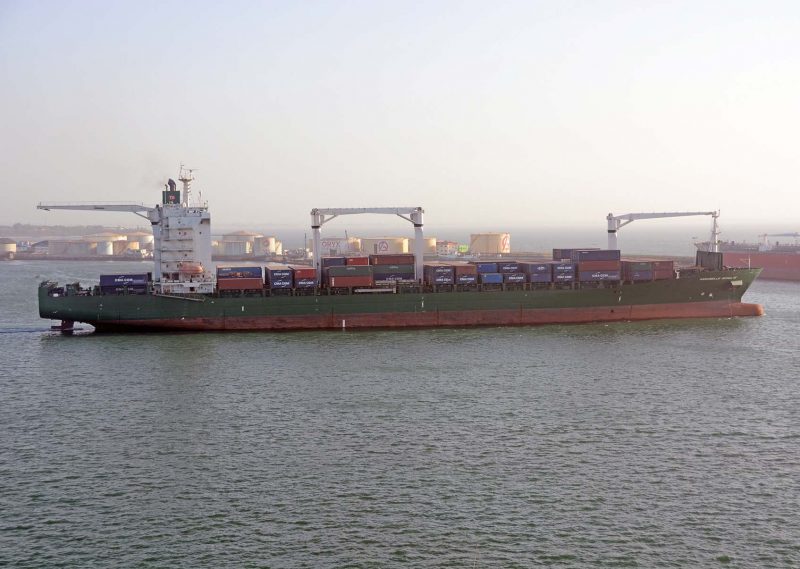
By 2005, there were a dozen tankers on charter or managed for Maersk Line, OMI Corporation of New York, Teekay and the oil majors, including the new tankers Everhard Schulte of 75,000 dwt and Angelica Schulte and Sophie Schulte of around 110,000 dwt as double hull tankers with a dozen cargo tanks and cargo pumps.
There were also gas tankers in Johann Schulte of 17,950 dwt, Wilhelm Schulte of 17,900 dwt, and the sisters Immanuel Kant and Tycho Brahe of 16,228 dwt. There was also a big fleet of managed bulk carriers, and a fleet of four managed ro-ro ships, NDS Prodigy, NDS Progress, NDS Prominence and NDS Provider.
The Schulte Group
The Schulte Group ship management activities were consolidated in 2008 through the combination of four ship management companies already operating within The Schulte Group. These were Hanseatic Shipping established in 1972, Dorchester Atlantic Marine established in 1978, Eurasia Group established in 1981 jointly with Oak Maritime of Canada and August Bolten’s William Miller Nach of Germany, and Vorsetzen Bereederungs und Schiffahrtskontor of Hamburg, based in The Schulte Group Head Office located on the Niederhafen Quay in Hamburg and established in 1999. This consolidation retained their separate brand identities, and they were operated from nine worldwide offices in Hamburg, Shanghai, Limassol, Athens, Hong Kong, Mumbai, Singapore, North Shields, and Douglas (Isle of Man), the latter office being a crewing recruitment subsidiary. The North Shields office is the British subsidiary of The Schulte Group and manages thirty gas tankers.
The owned Schulte Group fleet in 2009 comprised eighty vessels covering the container, oil and gas tanker, bulker and ore carrier fields. Two Capesize bulkers, NSS Fortune of 184,872 dwt and Pacific Prosperity of 180,300 dwt, and the giant ore carriers Pacific Ruby of 254,100 and Ore Fazendao, Ore Parati, Ore Santos, Ore Tubarao, Ore Urucum, and Ore Vitoria of up to 165,000 dwt were moving iron ore from Brazil and Australia to China. Ships were managed for American President Lines, Maersk Line, Libra Lines, Cosco of China, Algoma Central of Canada, Oldendorff Shipping and Opielok Reederei of Germany, Grupo TMM of Mexico, Goldenport Shipping of Greece, MC Shipping Inc of Monaco, MOL and other shipping companies and banks based in Bermuda, Japan and London. Three new container ships of 7,000 TEU capacity were on charter to APL for five years and were renamed as Angelica Schulte, Anton Schulte and Astrid Schulte at the end of their charters.
The multi-purpose general cargo ship Renate Schulte of 14.619 grt collided with the Maltese cargo ship Marti Princess in the Sea of Marmara off Bozcaada Island on 27th June 2009 in darkness at 2210 hours. Renate Schulte collided at right angles to the hull of the other ship and ended up impaled across the deck of Marti Princess in way of the number two hold. Marti Princess was badly damaged and open to the sea with a huge tear in her hold at number two hold. It took many hours for the two ships to become disentangled. Renate Schulte was in ballast, while Marti Princess was fully loaded with cement on a voyage from Turkey to France.
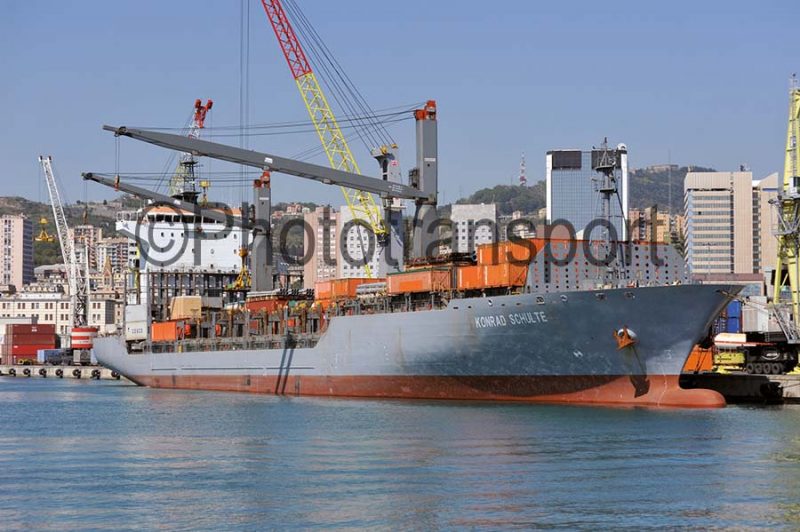
Today, some 95 fully or jointly owned ships are on charter to container companies, oil majors, and consortia and pools, and are part of a larger fleet of managed ships totalling six hundred ships. Container ships have been owned or managed since 1988, and today 190 container ships are managed by The Schulte Group of up to 13,000 TEU capacity. Six large container ships of 9,400 TEU were launched in 2012/13 by the Shanghai Jiangnan yard as the ‘J’ class of Jacob Schulte, Joel Schulte, Johanna Schulte, Joseph Schulte, Julius Schulte and Judith Schulte for charter to MSC Container Line. Feeder container ships are also in the fleet from 700 TEU up to 850 TEU capacity. A dozen ‘M’ class container ships of 2,345 TEU capacity were completed during 2015/16 by Far East yards as Mathilde Schulte, Max Schulte, Melchior Schulte, Mia Schulte, Molly Schulte, Mimmi Schulte, Majestic, Mariner, Meridian, Minerva, Mandalay and Minstrel, all equipped with three container cranes of forty tonnes capacity. Five container ships of 5,600 TEU capacity built in 2011/12 were on charter to MOL of Japan, and will revert to their ‘H’ class Schulte names at the end of their charters of Hans Schulte, Hedwig Schulte, Henrika Schulte, Hermann Schulte and Hubert Schulte.
Tankers have been owned and managed since November 1996, when five chemical and product tankers were purchased. Today, The Schulte Group have over 150 chemical, product and crude oil tankers managed from the same nine worldwide offices, with 73% of the fleet being product and chemical tankers, 10% Suezmax, 10% Aframax and 7% being VLCCs. Bulk carriers have been owned and managed for sixty years, and today The Schulte Group manage 120 bulk carriers carrying a broad range of bulk ores and cargoes from the same nine regional offices, with 42% being Handymax e.g. the bulk carrier Weser Stahl of 47,257 dwt, 14% Panamax e.g. Nordelbe, Ems, Brahms, Pugnani, Berlin and Paganini, 21% Capesize, and 17% being Very Large Ore Carriers of up to 400,000 dwt e.g. the Liberian registered ore carrier Phyllis N of 285,750 dwt managed by Bernard Schulte Ship Management (India) Pvt Ltd.
The owned fleet of 95 vessels comprises sixty container ships from 700 TEU to 9,400 TEU capacity, nine gas tankers of between 3,500 cbm to 20,600 cbm on charter to the Unigas pool, two Aframax crude oil tankers, eleven product and chemical tankers of up to 25,000 dwt, seven ethylene tankers of up to 10,700 dwt, one self unloading bulker of 47,250 dwt, two container and ro-ro ships fitted with stern ramps and with a lane length of 1,500 metres.
The Unigas pool has three German partners in Schulte, Sloman Neptun and Othello Shipping, with Schulte joining in 2004, and gas tankers including Irmgard Schulte and Immanuel Schulte of 23,100 dwt as well as the smaller Lady Hilde, Lady Margaux and Lady Kathleen of 4,000 dwt. Two new gas and ethylene tankers of 14,000 dwt joined the fleet in June 2016 and January 2017 from STX Shipbuilding as Zoe Schulte and Zita Schulte.
Fifth Schulte Generation
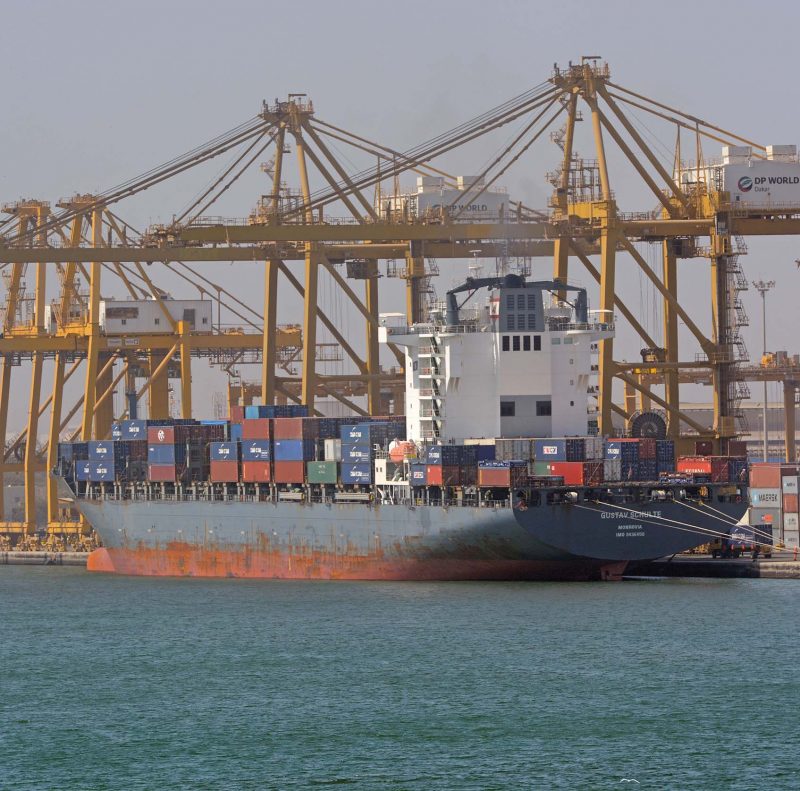
Two sons of Dr. Heinrich Schulte joined the company as partners in 2013 to form the fifth generation of the Schulte family of shipowners. Johann Bernhard Schulte born in 1982, and Hermann Christoph Schulte born in 1984, and together with their father, CEO Ian Beveridge, and senior management control the management of this colossal Schulte fleet of owned and managed vessels. A very large LNG carrier was ordered in 2014 of 174,000 cubic metres capacity from the Samsung yard in South Korea for long term charter to Mitsui of Japan for completion in 2018 as Comet Arrow with four giant cargo tanks.
Orders placed in 2016 include sixteen container ships in a joint venture with J. P. Morgan Ship Funds, five container ships in a joint venture with ICBC Leasing and Finance, and for several gas tankers. Six more Maersk Line container ships in the range from 2,500 TEU to 11,000 TEU capacity were given to The Schulte Group to manage in September 2015 for the next five years. A joint venture was formed in 2015 with Reederei Nord of Germany (Klaus Oldendorff) as O & S Chartering for chartering container ships and bulk carriers, with Borealis Maritime Ltd. (Christoph Toepfer) as the later third partner. This is now called Hanseatic Unity Chartering, and thus continues the ‘Hanseatic’ brand of ship chartering and ship management.
Bernhard Schulte Offshore has managed offshore support vessels for many years, but have now been appointed managers of two Ulstein SX175 Service Operation Vessels (SOVs) for the Windea Offshore joint venture of Bernhard Schulte Offshore, EMS Maritime Offshore and SSC Wind. The two vessels are on long term charter to Siemens A.G., the main contractor of the project. The two X-Bow vessels are named Windea La Cour and Windea Leibniz, completed in late 2016 and early 2017, and are of length 88.0 metres, moulded beam of 18.0 metres with a service speed of 13.5 knots and accommodation for 109 people. They will be tasked with wind farm construction and maintenance as well as working on some of the many offshore construction projects, and at the end of the Siemens charter will return to their Schulte names of Helen Schulte and Hermine Schulte.
A sense of history stretching back 135 years to the very beginning of Schulte and Bruns in 1882, and their operation of three masted schooners and brigantines including Balthasar of 287 grt, is commemorated today in a new container ship, Balthasar Schulte of 4,250 TEU capacity, for The Schulte Group. Clients appreciate this continuity and longevity, and those shipping companies taking Schulte ships on charter today include Allocean Ltd., Algoma Central of Canada, American President Lines, Cido Shipping of Hong Kong, Hapag-Lloyd Container Lines, Hamburg Sud Container Lines, Ignazio Messina, Maersk Line, Marfret, MOL, MSC, ER Schiffahrts Gmbh, D. Oltmann Gmbh, Opielok Gmbh, Commerz Real Fonds of Germany, MC Shipping Inc. of Monaco, Ship Finance International Ltd of Bermuda, National Shipping Corporation of Saudi Arabia, Nile Dutch Afrika Line, Petredec, an international shipping group with a fleet of over fifty lpg gas tankers, Union Maritime Ltd. and the Womar pool.
The original Schulte and Bruns timber, ship brokerage and warehousing business was sold to Klaus Fischer and his family of Papenburg in 1983. This has been built up into a big business occupying a prominent site on the river at Papenburg covering forty acres with 40,000 square metres of storage area for timber brought in by a fleet of owned and managed coasters. On 1st January 2017, the Hartmann Group of Germany merged their short sea shipping operations with those of Schulte and Bruns as equal partners in Schulte and Bruns Chartering, responsible for all of their short sea shipping. Thus, the name of Schulte and Bruns is still active in shipping and related businesses after a magnificent continuous period of 135 years.
Postscript
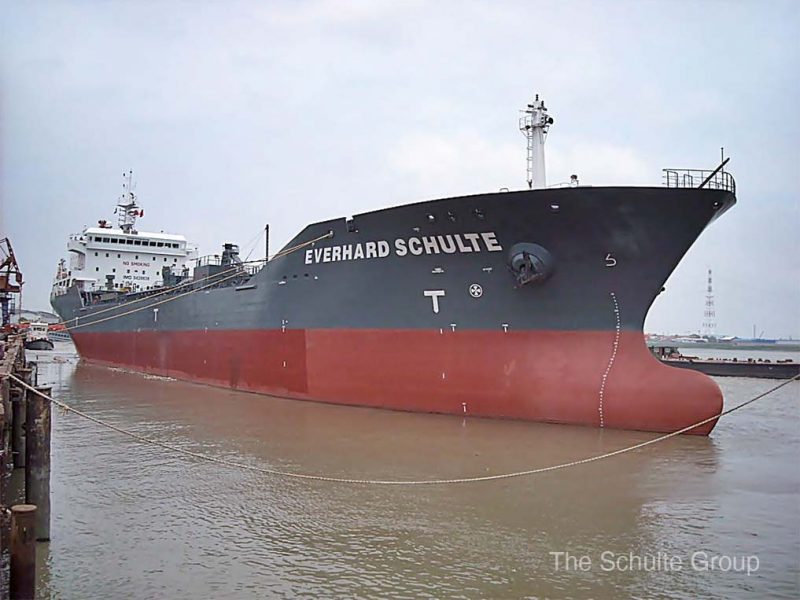
Highly experienced and professional ship management companies such as The Schulte Group charge a management fee covering the maintenance, crewing, obtaining of charters, and the services of very experienced shipping industry professionals to advise on all aspects of ship operation. This is of immense value to many international mining, manufacturing and oil companies which have no experience in the shipping industry or do not wish to have dedicated shipping departments for their fleets of bulk carriers and tankers carrying their raw materials and finished products. The huge number of managed ships looked after by the big ship management companies allow reductions in price for bulk purchases of paint, stores and lubricating oil, with further reductions in ship insurance policies.
The Schulte Group are in the forefront of marine technology and expertise, with their latest ‘C’ class of 5,400 TEU container ships, Carl Schulte, Charlotte Schulte, Christa Schulte and Clemens Schulte, meeting stringent international fuel emission and efficiency standards. Schulte Marine Concept (SMC) are based in Germany and take a specification from a client for a newbuilding through the design, construction and commissioning stages, particularly for economical bulk carriers. Hanseatic Cruise Services are based in Singapore and provide passenger vessel management services in partnership with Optimum Ship Management. The Schulte Group has grown enormously during the last twenty years, with six hundred current owned and managed vessels employing many thousands of seafarers as well as hundreds of shore staff, and these numbers will increase in the future as the stated intention of the Schulte family is to increase the managed fleet.

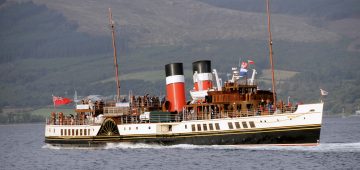

Comments
Sorry, comments are closed for this item